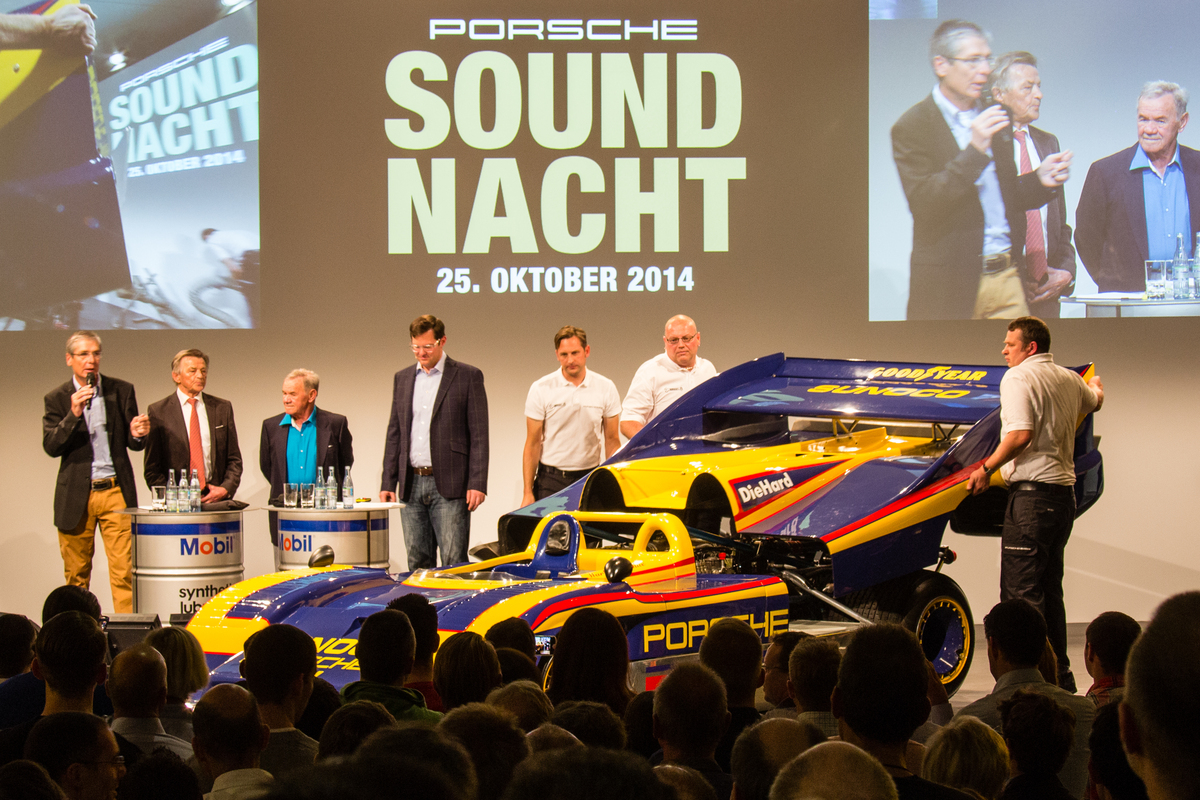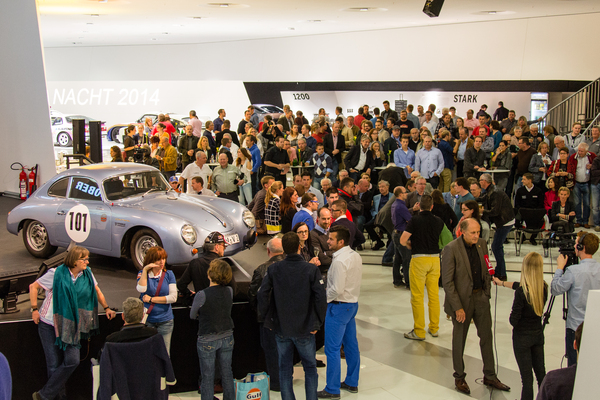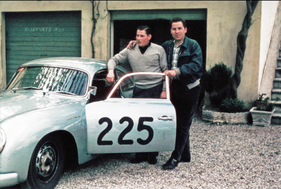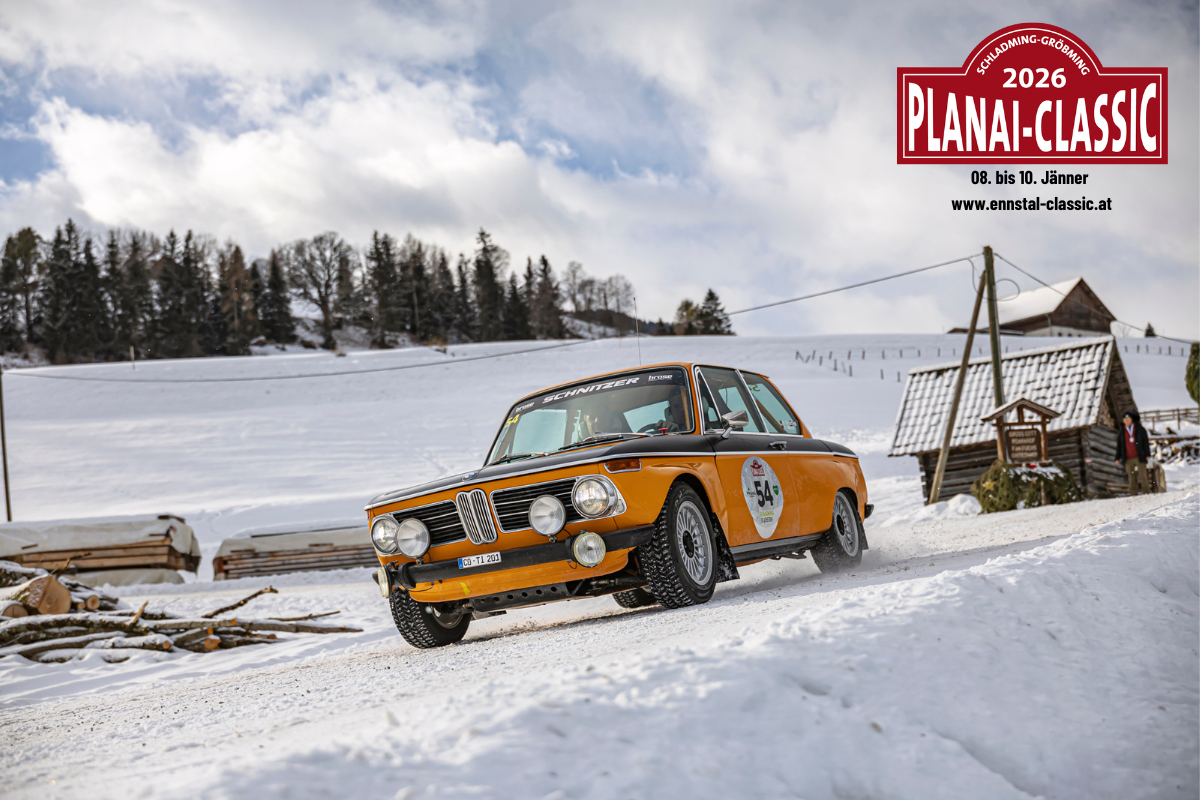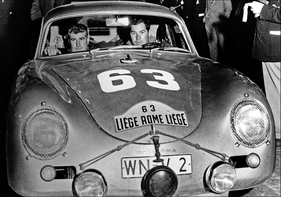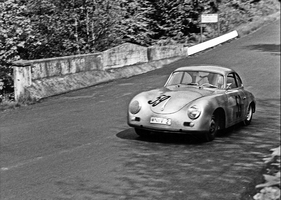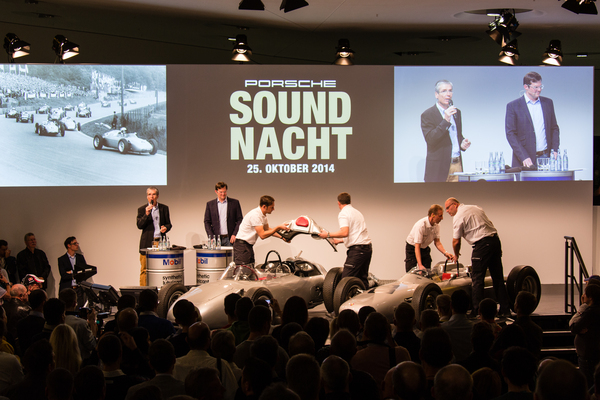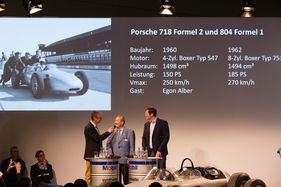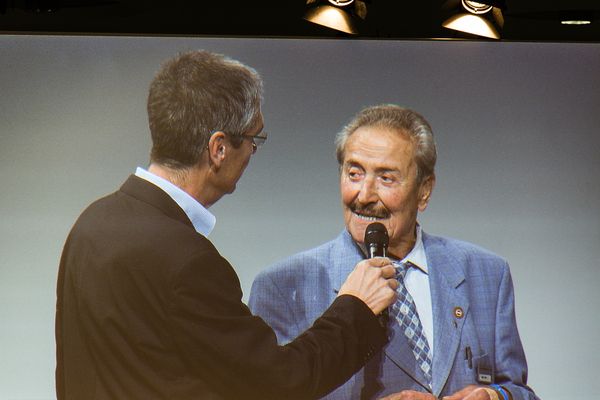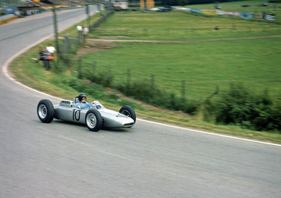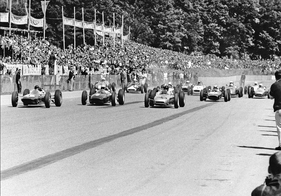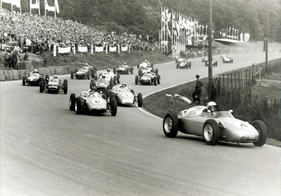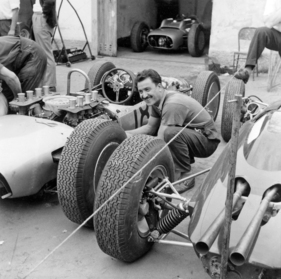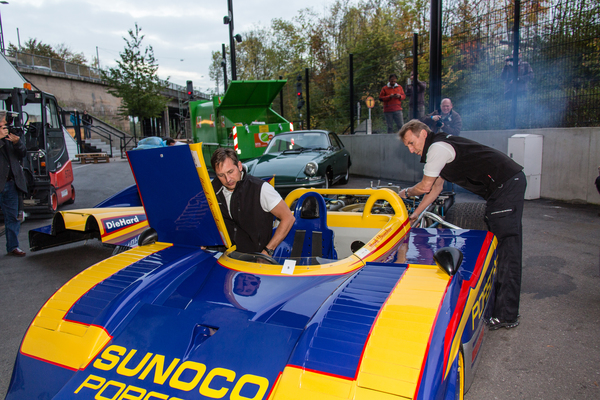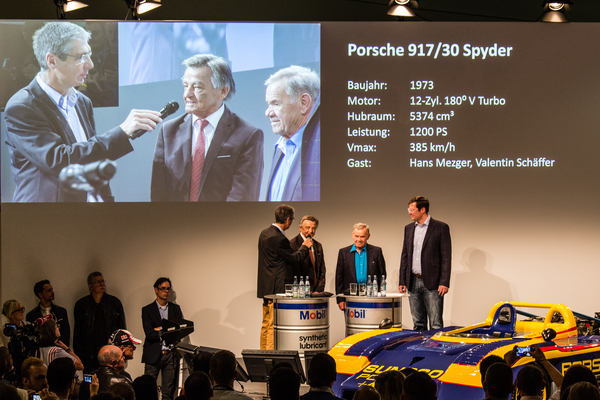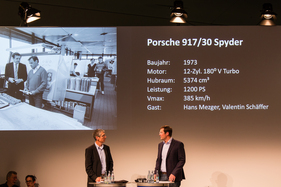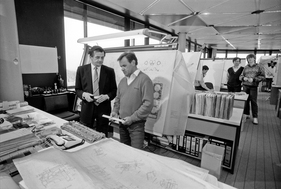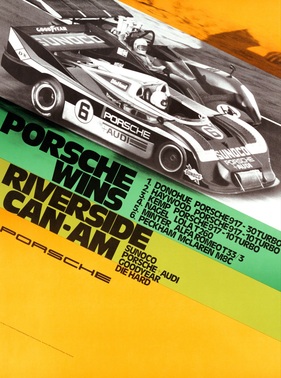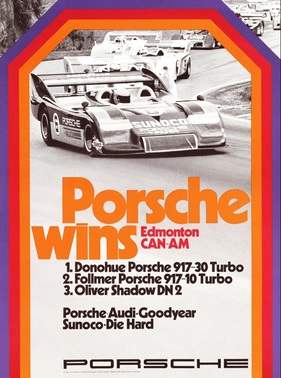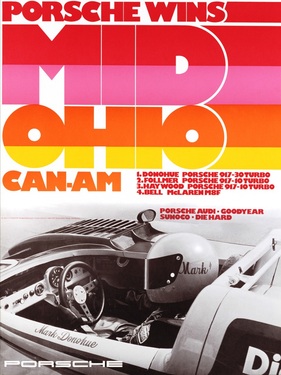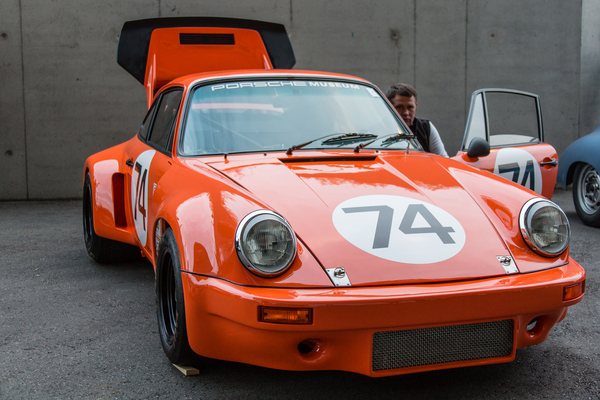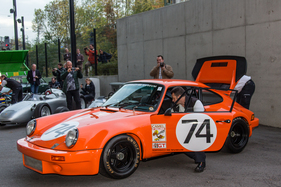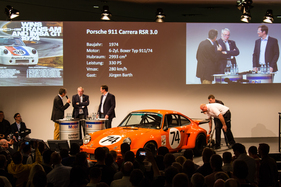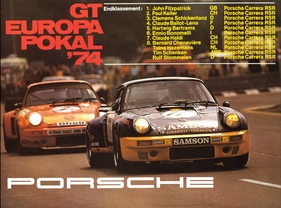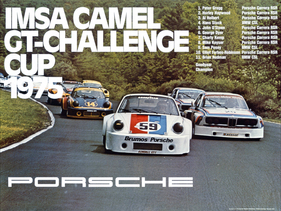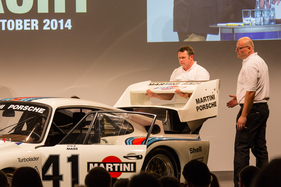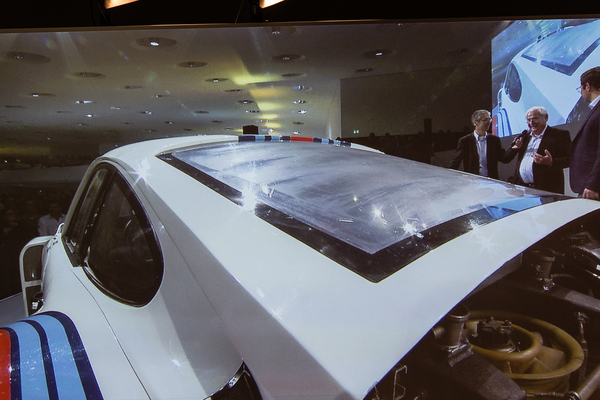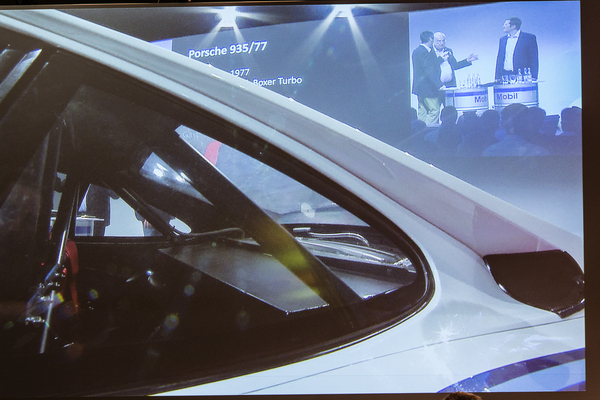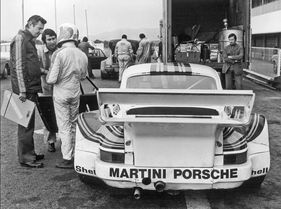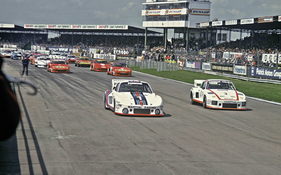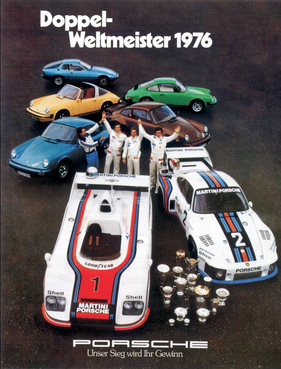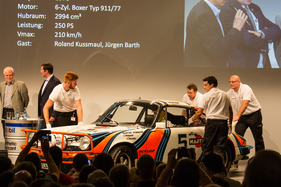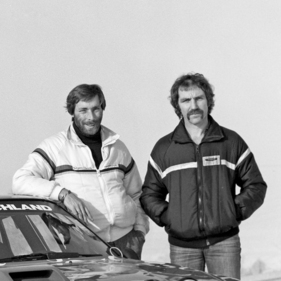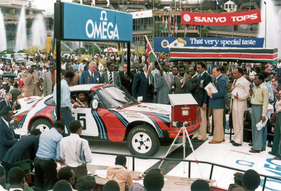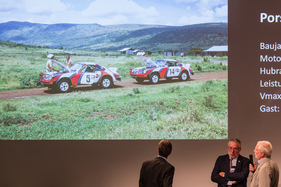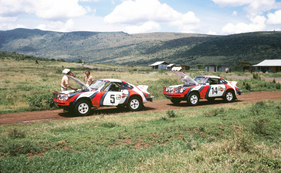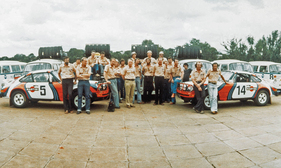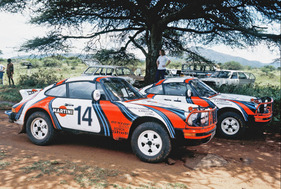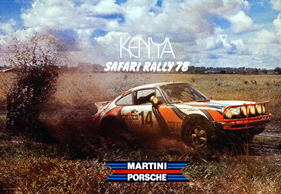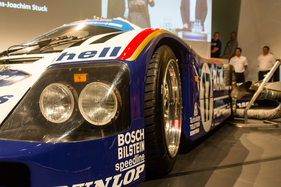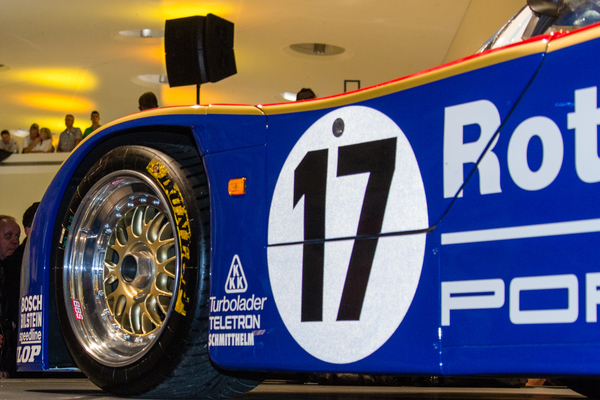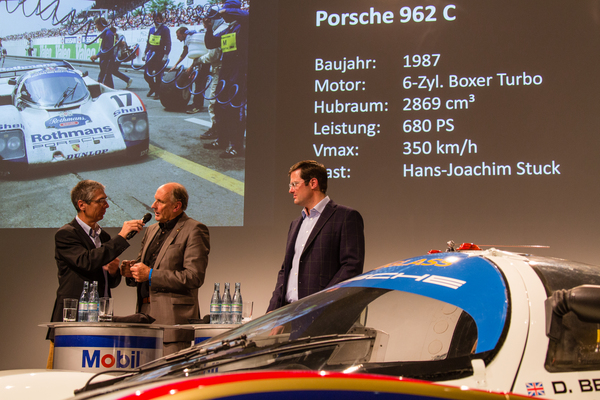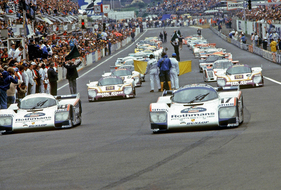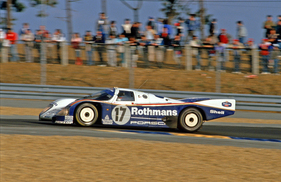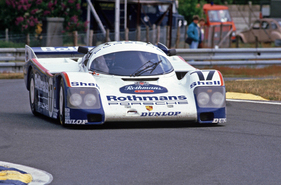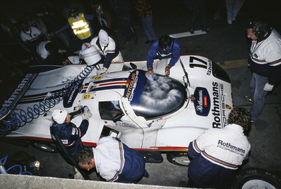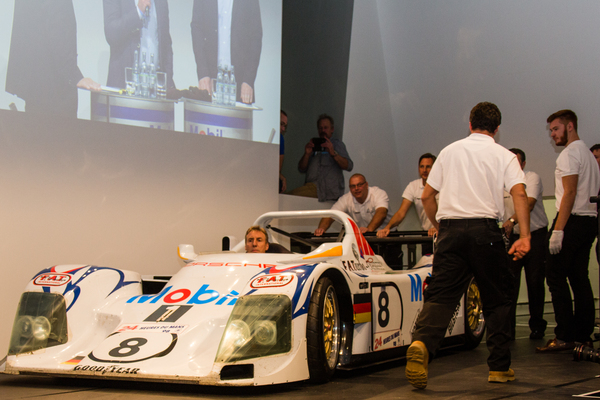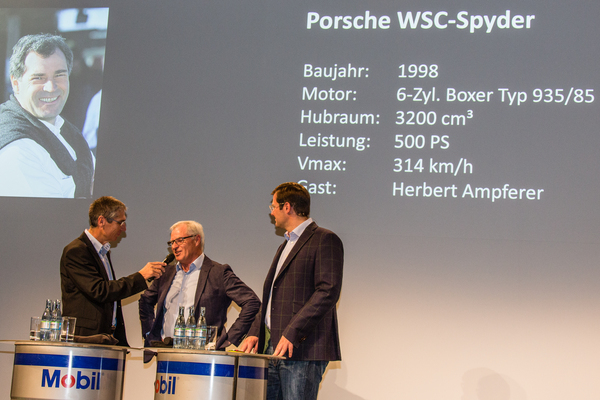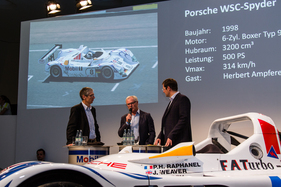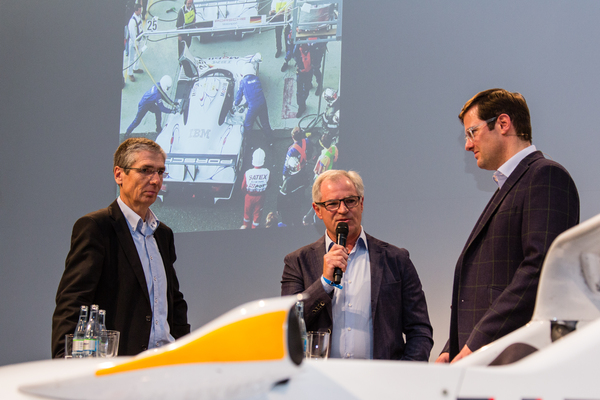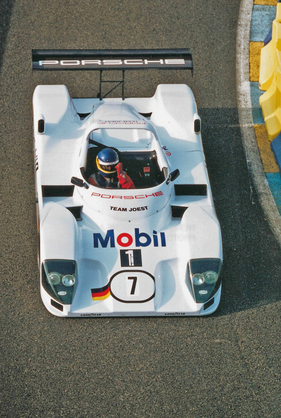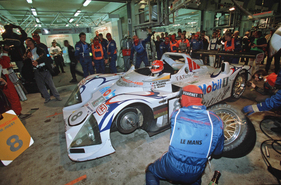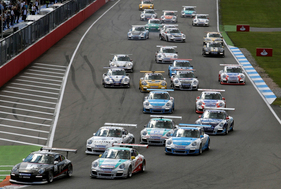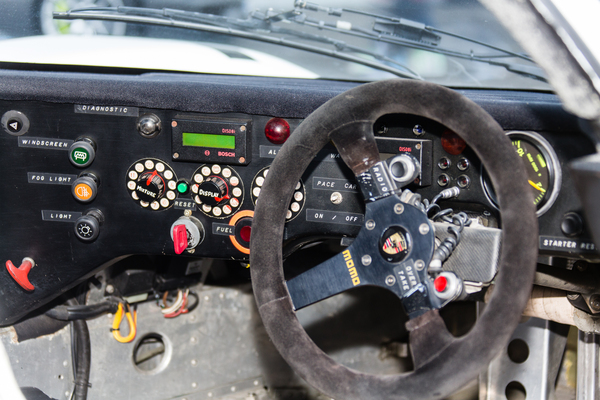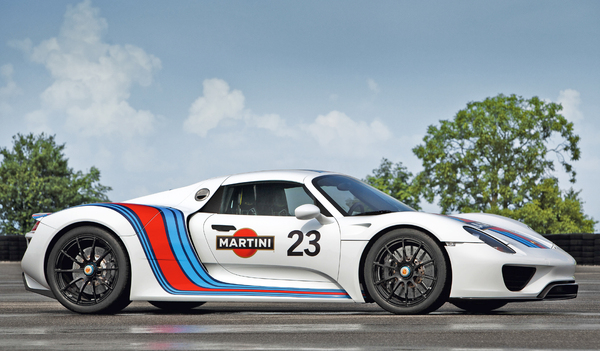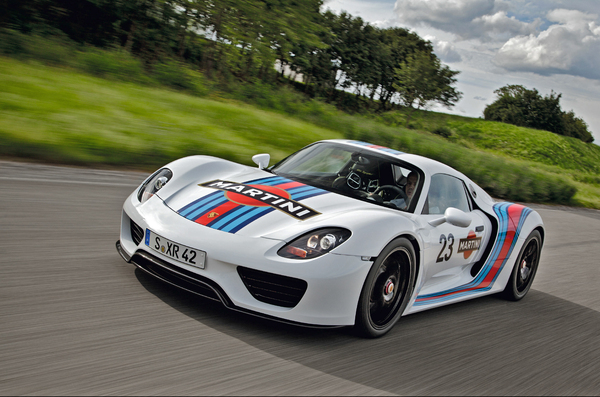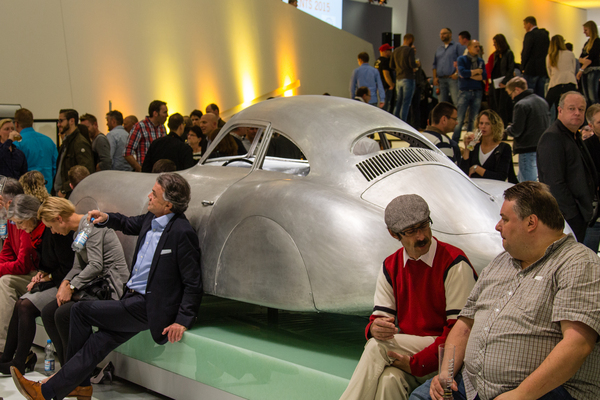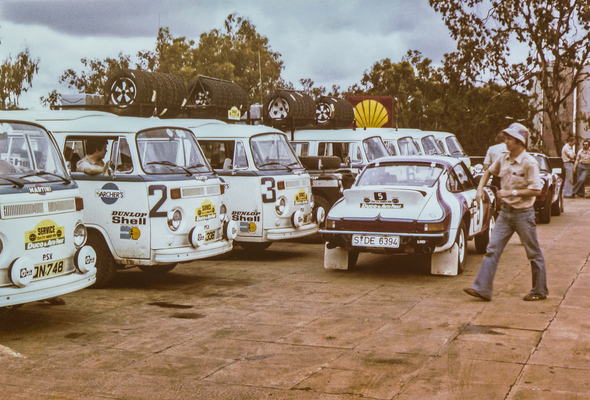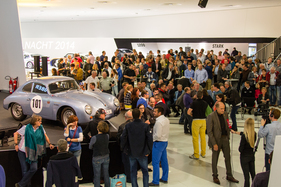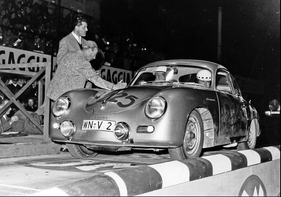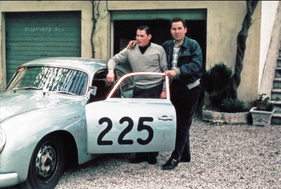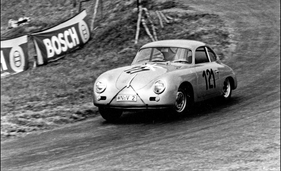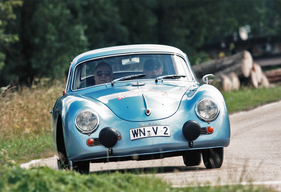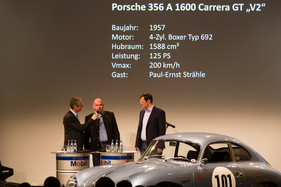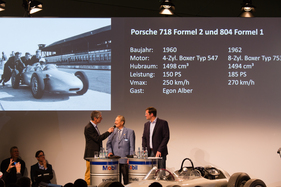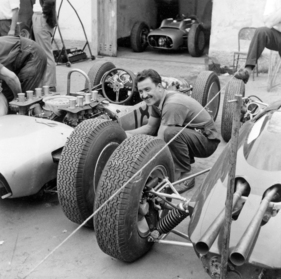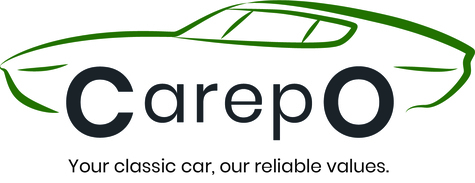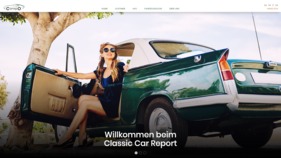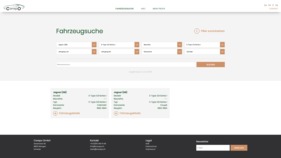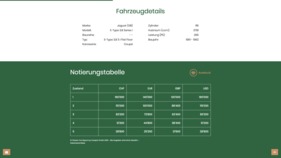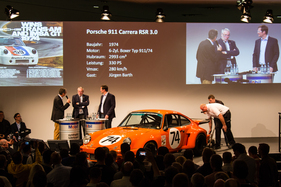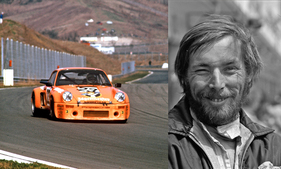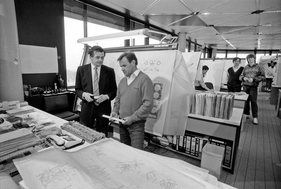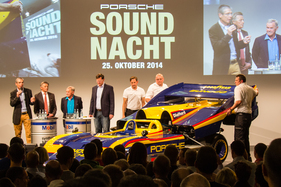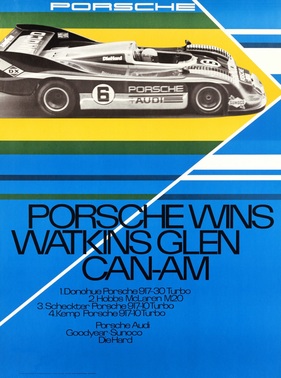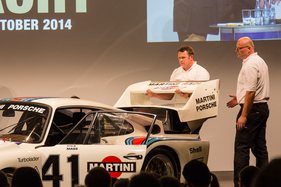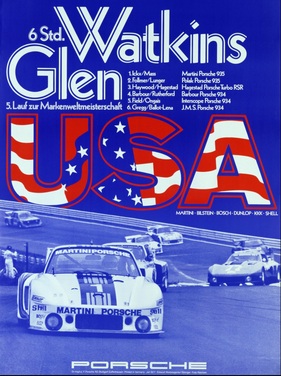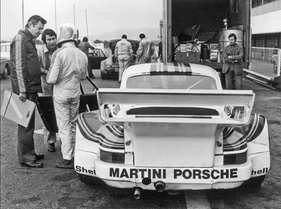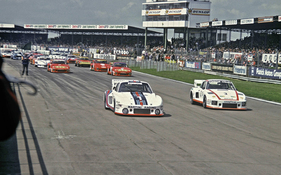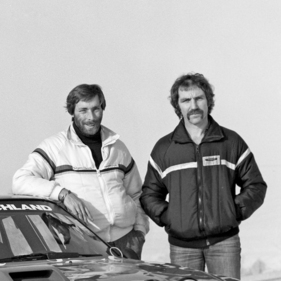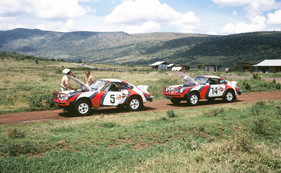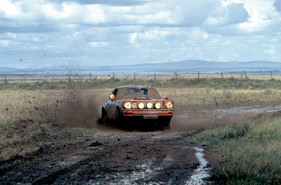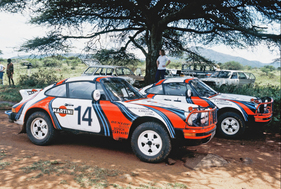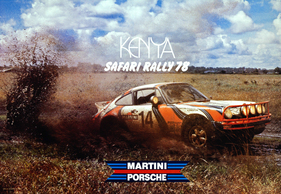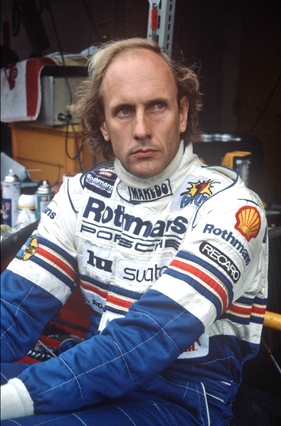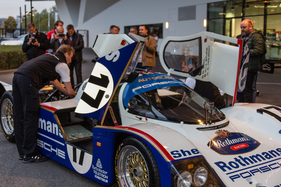At the fourth edition of the Porsche Sound Night, Achim Stejskal, Director of the Porsche Museum in Zuffenhausen, did not miss the opportunity to personally welcome the audience, some of whom had traveled from far and wide.
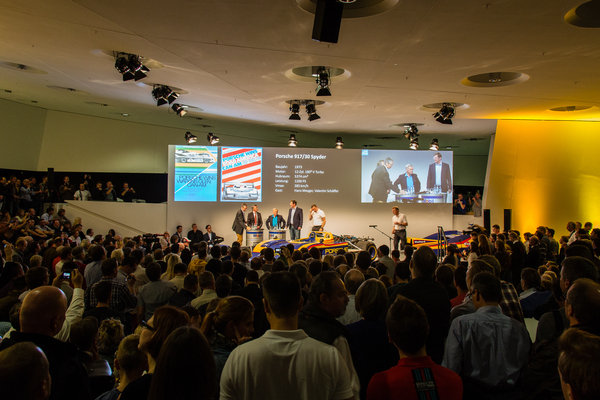
Those who had managed to get hold of one of the coveted 911 tickets were able to view the exhibition before the event, which, as is well known, only shows part of the 500 vehicles that the museum has at its disposal.
The evening was expertly hosted by well-known motorsport commentator Walter Zipser and Dieter Landenberger, Head of the Porsche Archive and very familiar with the subject matter.
Porsche 356 A 1600 Carrera GT "V2"
It all started with a vehicle that, although not very visually striking, has a lot going on behind the ears or under the hood. It had a racing engine whose speed and sound are still legendary today. Equipped with dry sump lubrication, dual ignition, twin carburetors and 4 camshafts, the engine, which is made of aluminium in all essential parts, was given ingredients that are otherwise only found on the racetrack in line with the typical Porsche motto "Every sports car is a racing car."
The Porsche 365 A Carrera, available from 1955, was impressively represented by the car that Paul Ernst Strähle once drove to numerous victories. The racing driver's son presented the "V2" with obvious pleasure and recounted the very emotional process of his father buying the car back. Given its excellent condition, none of the spectators wanted to believe that the Porsche really has over 500,000 km on the clock.
However, if you consider that the 356 was not only used as a training car, but was also used for test drives on behalf of Porsche, the high speedometer reading is quickly explained.
The numerous victories of what was probably the most successful racing Carrera ever include wins in the Liège-Rome-Liège, the Mille Miglia, the Tour de France and the Tour de Corsica. It is also worth noting that Paul Ernst Strähle was one of the few purely private drivers at the time!
With the approval of Huschke von Hahnstein and others, a Carrera GT bodyshell was purchased from the Reutter company and then rebuilt using parts from another car that had been involved in an accident. The result was enough for two victories in the Targa Florio, three times for the 1000 km on the Nürburgring and countless other races and victories.
The car owes its legendary "V2" license plate number to the official at the registration office. The license plate WN-P1 was already taken, and Strähle thought the alternative number "V1" was unsuitable. "You can't go to Italy with that," and since "V2" and "V3" were still available, all three license plates were simply reserved. The Carrera Speedster got V1, the Carrera GT got V2 and the number WN-V3 is probably still waiting to be used today.
Porsche Type 718 Formula 2 and 804 Formula 1
From 1903 to 1965, Solitude on the outskirts of Stuttgart was Porsche's home race track and in 2015, Porsche will once again be represented by the museum at the Solitude Revival.
Two cars that were fast not only at Solitude but all over the world back then will be next on stage. We come to the topic of Formula 1 and Formula 2.
1957 saw the start of Formula II, the regulations required vehicles with free-standing wheels, so a monoposto with a slightly longer wheelbase and larger tank was created based on the 718 RSK. The four-cylinder engine produced 155 hp. One of the seven examples built since 1959 was pushed onto the stage. In 1960, the 718 won six out of twelve races, a good prerequisite for entering Formula 1, and so Ferry Porsche agreed to the development of the 771 in 1960. An elaborate 1.5 liter eight-cylinder engine with 240 hp was created, which competed in the 1962 Rouen Grand Prix in France.
On this memorable Sunday, July 8, 1962, Adenauer was a guest of De Gaulle in the morning - 17 years after the end of the Second World War, this was a historic mission. After the statesmen had attended mass together in Reims Cathedral in the morning, Porsche won the Grand Prix on the race track in the afternoon.
The invited guest is celebrating 70 years of Porsche this year. Egon Alber, whose career at Porsche began in 1944 at the age of 14 as an apprentice and who later raced with Jim Clark and Graham Hill, received an enthusiastic welcome.
As an engine fitter alongside Hans Mezger, he experienced a lot at Porsche. With shining eyes, he reports on the production of the 2-L eight-cylinder Type 771 with one crankshaft, two intermediate shafts, four main shafts and four camshafts and lots of bevel and ring gears - you couldn't imagine a bigger job for a mechanic.
And during the first test on the test bench, nothing happened. The engine didn't make a sound. But Egon Alber was exonerated, it wasn't his fault, the design department had to rework...
He still regrets today that his Formula 1 involvement soon came to an end. Even back then, the mechanics traveled the world, with Alber's list of assignments extending as far as Buenos Aires.
During a race there, Porsche ran out of crankshafts after countless engine failures. So that Hans Hermann could drive, they swapped Wolfgang Seidel, who had run out of tires, for a set of tires and the promise that the next time he came to Zuffenhausen, he would get a new Hirth shaft, a crankshaft on site, with the help of which Porsche was able to build an engine and win the class.

The sound of the Formula 2 Type 728 and the Formula 1 Type 804 in a duet at the Sound Night 2014 made the fans cheer.
«Your classic car, our reliable values.»
8855 Wangen SZ, Switzerland
- Automobile Historian
- Automotive Expert & Appraiser
Porsche 911 Carrera RSR 3.0
Of Porsche's 30,000 racing victories, 20,000 are attributable to the Type 911. A very special model was presented at the Sound Night: The 911 Carrera RSR 3.0! 110 of the 3L version of the car designed for Group 4 were built, 57 of which were RSRs. In the hands of customers, it was the sports car to have in the mid-seventies.
Jürgen Barth, who had won the 24 Hours of Le Mans in 1977, took to the stage. However, his hairstyle today no longer matched the one in the photos from his racing days back then. If Huschke von Hanstein had still been alive back then, he would not have gotten into the car without an immediate trip to the hairdresser.
The large rear spoiler was the beginning of aerodynamic considerations and brought about significant improvements from 60 km/h upwards. It is the continuation of the first efforts with the rump on the 2.7 liter RS.
Jürgen Barth was really enthusiastic about the car's performance. Just last week, he became champion in the GT1 class in an ex-Kremer RSR in the Classic Endurance racing series and "I still enjoy it as much as I did back then".
How does the car drive? The original answer: "Like a Volkswagen. You get in, turn the key, the engine starts immediately, with the synchronized gearbox it starts smoothly, just like a Volkswagen - like a Porsche".

The challenges back then were already tough. As soon as the Monte Carlo Rally was over, we quickly went to Daytona to take part in the 24-hour race. From the ice and snow into hot Florida and then into the cliff face at 280 km/h, it took three to four laps before you were ready to put the pedal to the metal.
And then in mid-November this year we're off to the Daytona Revival with a 917 longtail, where we'll also meet Quester again.
Porsche 917/30 Spyder
Engine designer Hans Mezger, a Porsche veteran, was present, accompanied by Valentin Schäffer, who assembled the racing engines from 1955 to 1989. His comment was: "Hans drew and I built!".

The most powerful Porsche of all time, with 1200 hp, is still fascinating today - and not just for the designer on the stage. With a torque of around 1200 Nm (!), something was going on, said Valentin Schäffer, who once accidentally measured a good 1400 hp when the throttle cable got stuck on the test bench and the engine really revved up.
Of course, one or two parts flew through the air during development and the test bench tests. It also happened that the mercury from the measuring instruments for determining the boost pressure landed on the ceiling along with the measuring equipment.
The beginnings of the turbo era were rocky for Porsche, as they started from scratch with the technology that was new to the Zuffenhausen-based company at the time. The 1000 hp desired by Piech could not be achieved with one turbocharger, so after consultation with a supplier, two were simply installed.
The turbo technology itself had already been known for a long time, but at that time turbo engines were unsuitable for production vehicles, as they were only designed for constant power output and not for power and load changes. Only the bypass valves for boost pressure regulation, discovered by Porsche in the USA, made stable power regulation of the engines possible.
1972 was planned as a learning year, yet Porsche won 6 out of 9 races. Unfortunately, Marc Donohue had to pit briefly in the first race and then only finished second. In 1973, the 917 simply drove everything into the ground in the Can-Am series and just one year later, turbocharging was also on the starting grid in the 911. Incidentally, no one has ever disputed the 917's record as the fastest accelerating racing car: 11.4 seconds from 0 to 300!
A small detail in passing: with an aerodynamically optimized version of the 917/30, Marc Donohue achieved an average speed of 385.85 km/h on the oval at Talladega in Alabama in 1975, accompanied by Valentin Schäfer, who was also on board for a truck record run that day.
Porsche 935/77
When the era of Group 5 production racing cars began, Porsche also managed to win the world championship here. The legendary racing engineer of the time, Norbert Singer, took to the stage and explained how the sporting regulations at the time developed away from the prototypes and towards the production cars. The basis for the 935 was simply a 911 Turbo. However, as the regulations allowed for interpretations, the car did not quite look like a production 911.
Jacky Ickx, Klaus Ludwig, Jochen Mass and Rolf Stommelen - to name but a few - were the tamers of the cars, which boasted a power range of between 460 and 650 hp. To list all the victories from 1977 and 1978 would go beyond the scope of this article. In addition to performance, the stability of the engines was the basis for these countless victories.
Of course there were also minor problems, for example at Watkins Glen, where the blow-off valve on the leading 935 had worked its way out of the engine compartment hanging from the hose. The race organizers did not notice this and fortunately everything held up to the finish.
One detail worth mentioning is the car's two rear windows. The original rear window from the 911 was aerodynamically too slanted to achieve the perfect airflow to the rear wing. However, as the regulations only stated that the original rear window had to be retained, a second, flatter rear window was simply built over it. However, the stewards first had to get used to this. The following year, a similar approach was taken with the doors, and the modifications were very successful in terms of aerodynamics.
A nice story from 1977: At that time, a "two times three-hour race" took place at the Hockenheimring, i.e. a 3-hour race on Saturday and one on Sunday. However, the Dunlop tires supplied had a manufacturing defect that resulted in terrible handling, only with the qualifying tires everything went perfectly. After the engine gave up in the middle of the first race, the matter was actually over.
However, so that the public could see the car again, the car was to take part again on Sunday. So they took part in the second race out of competition, but the problem of the unsuitable tires was still not solved. So, without further ado, they drove on the qualifying tires, which actually only lasted two laps - for the remaining 28 laps, the drivers Ickx and Schurti had to see how they would survive.
There were actually few problems with the tires, at the first pit stop only the canvas was sticking out, but the air pressure was still okay. If the car hadn't been out of contention, it would even have won the race.
Porsche 911 SC Safari
The warhorse Roland Kussmaul, about whom it was written that he was "a dyed-in-the-wool 911 junkie and such types are unfortunately no longer produced today", was an engineer and works driver in one person, also blessed with golden mechanic's hands.
His performance is often underestimated; for example, he achieved sixth place in a Paris-Dakkar with the service vehicle, which was around 100 kg heavier than the official service vehicles due to the spare parts it carried!
Even more adventurous were probably missions on the East African Safari, 5,000 km across Africa, where rented VW buses took over the service, supported by Mr. Bott and Mr. Falk in an airplane that acted as a radio relay station. There were no cell phones back then, and phone booths were also nowhere to be found in Africa.
The message came over the radio: Waldegaard had a problem with the axle shaft. So Kussmaul grabbed a shaft and started to apply grease to it on the journey. You can imagine what the inside of the car looked like afterwards.
When Kussmaul saw Barth's service plan for the first time, he thought "he's out of his depth". As planned, the VW buses had eight hours to cover 700 km on gravel roads and Kussmaul wondered how that was supposed to work. However, as the rally vehicles always arrived 3 to 4 hours later than planned in the schedule, it still worked somehow, often tightly, but still.
However, you have to have the courage to make such plans, and that with only six service vehicles - Mercedes had three times as many in use that year. The following incident proves that Jürgen Barth values Roland Kussmaul as the best co-driver in the world: in 1979, they both drove an extreme rally in Australia, 20,000 km in 14 days in a Porsche 924. During the drive, it started to smell strange inside the car, so Kussmaul crawled into the back to sort out the problems with the fuel supply - at full speed, of course!
Africa offers very special challenges with its greasy soil, which contains a lot of sand. After training, the wheel arches and underbody were covered in up to 160 kg of mud and dirt, and the material hardened as it dried and could only be removed with a chisel. Extra deflector plates made of high-quality material even had to be made and fitted for the brake system, as otherwise the dirt would get stuck inside the rims and damage the brake system.
One of the best rally filmmakers of all time, Helmut Deimel, was also present. His film series "Evolution of the Drift Angle" gives an impression of what rally driving meant back then and is highly recommended to all interested fans.
It has happened before that you end up in a huge water hole on the bad roads between Nairobi and Mombassa after an almost endless jump of the rally car and then have to replace the rear axle control arms. It's just a good thing that nobody saw them in their shorts afterwards. The visit from various beetles and insects in the sleek leggings was also said to have been anything but fun, but that was motorsport at the time.
The sound of the car with the exhaust open, which captivated many that evening, also had its drawbacks. Having ended up in a ditch, it took a long time to get some Masai to help push it along. Unfortunately, this only worked until the engine was started, after which everyone was gone again.
But without the help of the locals it was often impossible. The regulations did not provide for four-wheel drive at that time and the long inclines with wet, loamy ground could hardly be mastered with front or rear-wheel drive.
If you got stuck halfway up the slope, a local would often come and ask for "push money". But you had to quickly negotiate how many Kenyan shillings the help was worth. If the next car came into sight, the enterprising helper would be gone - off to negotiate with the next car.
Once an agreement had been reached, 30 men would come out of the bush and push the car up the rest of the mountain. The trick was - some people realized this too late - to tear the banknote in two: one part was given immediately, the other only at the top of the hill. If you handed over a whole bill straight away, they were all gone again.
Stories like this often caused hilarity on the sound night. The car on display was only "softly" restored by the museum with the aim of keeping everything except the technology as original as possible. Even the first-aid kit, which melted in the African sun, has remained in the car.
Porsche 962 C
The most successful racing car of all time was presented after the break. The first race in 1982 at Le Mans ended with a "1st, 2nd and 3rd place victory". Seven Le Mans victories and eleven world championship titles went to the car with which Hans-Joachim Stuck is closely associated. However, Stuck only won at Le Mans when he drove for Porsche; his earlier attempts in other makes were less successful.

He enthusiastically told us that on the country roads that are part of the Le Mans circuit, the many short white center lines at 320 km/h created a continuous line - a great feeling, according to "Striezel", who said he enjoyed it every lap anew.
It's cooler at night in Le Mans, there are fewer distractions, you drive with more concentration, Stuck's preferences back then can also be transferred to the freeways today ...
A special seat was needed; the "Stuck seat" had a different curvature of the backrest and only then did the giant just about fit into the car.
The Le Mans victories were the greatest thing for Hans-Joachim, because as a racing driver he thought you had to have won one of the three races once: Indy 500, the Monaco Grand Prix or Le Mans.
Stuck and Kussmaul had probably done the most kilometers in the car, including in Weissach. There were weeks when Striezel sat in the car three days in a row, the mechanics would fill up the car late in the afternoon and then go home. Stuck drove until the tank was empty, then it was time for him to call it a day.
Even if the Porsche comeback at Le Mans in 2014 didn't work out this year, Striezel is certain that it won't be long before the first victory. The development of the Porsche dual-clutch gearbox, which began with the 962, inspires the racing driver. The time saved and the fact that you can stay on the gas when changing gear quickly made him forget the initial development problems.
This created the basis for today's circuits in motorsport and since 2009 this technology can also be found on the road in the Porsche 911.
Porsche WSC Spyder
The next car barely fitted into the vehicle lift, but nevertheless arrived on stage undamaged and was accompanied by the 1998 race director, Herbert Ampferer.
Actually, everything that ultimately led to the Spyder went back to considerations from 1993. Discussions were held with the organizers of Le Mans about how motorsport should continue. The thinking at the time was that Porsche was the world's largest manufacturer of GT road cars, so GT motorsport had to be kept alive.

In 1994, the first GT victories were achieved and the idea was pursued further. The following year, the idea of another Le Mans victory was crushed by the big boss (the background to this is revealed in the annual report)
But better times came, thoughts remained with GT motorsport and so the green light was given for Le Mans and GT racing based on the 911 in 1996. But Wiedeking wanted to see victories! However, they were not really sure whether this would work straight away and this led to a two-pronged approach, with a GT1 road sports car on the one hand and a GT2 racing car on the other.
The latter was based on a chassis from Walksinshore Racing in the States, powered by a 935 turbo engine. However, Joest Racing had to give the car a helping hand, as capacities at the factory were fully utilized. The strategy was well chosen, in 1996 the Joest WSC was even faster than the GT from the factory.

The same result in 1997, but the GT vehicles were clearly faster. They just couldn't reach their goal, but a Porsche still won. In 1998, the same game was played again, but the 935 parts were slowly running out, so a GT1 engine with a displacement of 3.2 liters was used in the WSC and, for the first time, a sequential gearbox.
There were also other achievements, such as the coasting cut-off, which significantly improved the refueling range; 13 laps in a row at Le Mans was quite a feat at the time.
The 500 hp WSC cars then had bad luck in the race and both retired, but the one-two victory of the GT1 cars finally gave cause for celebration!

Herbert Ampferer's favorite sound - "the way most 3.2l turbos sound" - was then heard. It goes without saying that the car - like all the others - had completed a proper warm-up behind the museum about an hour before the sound check.
Porsche 911 GT3 (Cup 997)
With the motto "The fascination of sports cars", the 911 naturally has to play a leading role. The 997 from the current one-make cup, which also won the parallel Facebook poll, took on the task of building a bridge to the present day. Michael Dreiser, head of the international one-make cups since 2009, was a guest at the Sound Night and was happy to talk about his experiences.
There are now 19 one-make cups around the world, including in the Middle East, where racing takes place from October to March. Hardly a weekend goes by without GT3 Cup cars on the racetracks of this world, and the enthusiasm has even reached Australia.
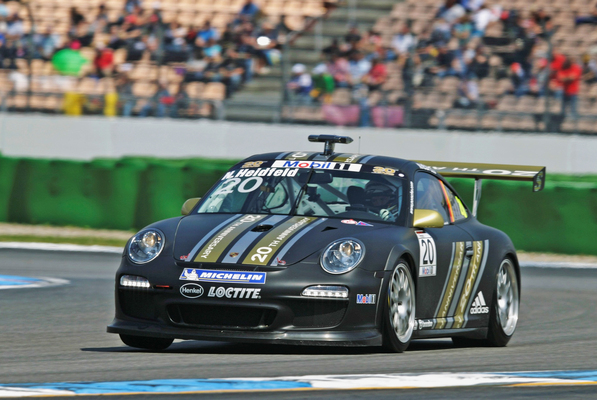
The cars roll off the production line 1:1 with the series vehicles in Zuffenhausen and are then specially adjusted and checked in Weissach, otherwise the almost 300 vehicles required per year would not be possible.
Compared to the production cars, the Cup cars have no other extras in the interior apart from the roll cage; the car is simply trimmed for racing. In the 997, the big step was to switch from the H-shift to the sequential claw gearbox in order to get the 450 hp with the corresponding exhaust system in the Supercup variant onto the road as quickly and cleanly as possible.
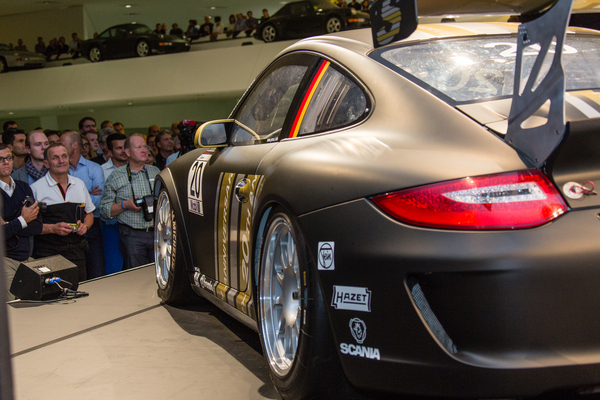
And then there was plenty for the audience to listen to, because even modern Porsches can sound good.
Porsche 918 Spyder
The last car of the evening drove onto the stage quite atypically under its own power and whispering quietly, in purely electric mode. A complicated car, 3 engines, all-wheel drive, many systems can be controlled quite simply via a handwheel in a "housewife-friendly" way.
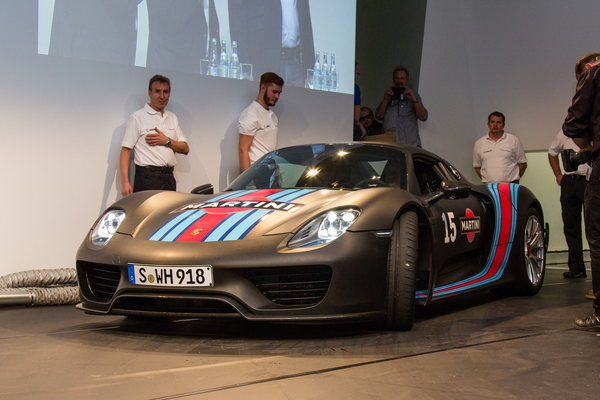
Eugen Oberkamm enthusiastically explained the car, which has 260 electric horsepower, 273 patents and has now completed 2.3 million test kilometers. The combustion engine is started within 50 milliseconds, and consumption of 3 liters per 100 km is said to be possible when driving at a leisurely pace.
Hardcore technology fans will be reconciled to these figures: 1250 Nm and acceleration from 0 to 300 in 19.9 seconds, i.e. faster than the Bugatti - who cares about fuel consumption?

Walter Röhrl said during his drive at the Nürburgring that he didn't drive for time, the racing drivers should drive really fast and came into the pits on the second lap with a time of 7:04. Marc Lieb then took the world record with 6:57.
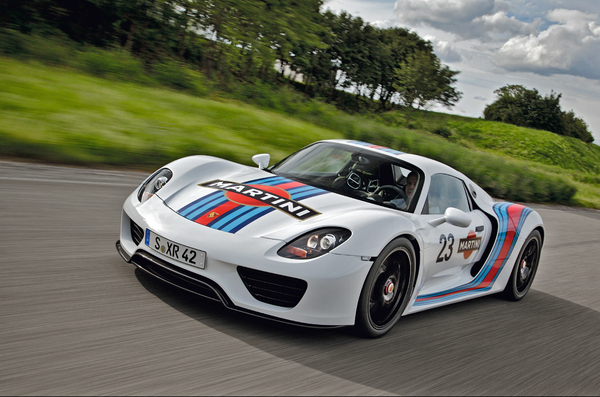
This road-legal car - not a racing car - set world records on 7 race tracks, including of course the Hockenheimring. You simply have to experience the car, but not everyone is allowed to experience this elemental force for themselves. However, the visitors that evening were able to enjoy a representative Nürburgring video that presented impressive driving scenes.
And to put it in Jürgen Barth's words: "It simply drives smoothly". ... just like a Porsche ...
